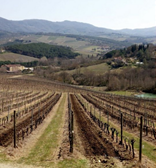Use of biodigestate to improve vineyard efficiency
Results of the experiments done at Castello di Gabbiano thanks to Uva Pretiosa funding

The application of biodigestate to the inter-row system is a valuable aid for the winegrower in trying to cope with an increasingly unpredictable climatic situation. The aim of this research was to evaluate the eco-physiological behaviour of vines subjected to four soil treatments (digestate treatment under cover, buried, mineral fertiliser and control), to check whether any physiological differences might have affected the eco-physiology of the plant and the quality of the berries.
It can be said that the buried digestate thesis presents optimal values of gaseous exchanges directing the plant towards a better vegetative performance, while the control shows parameters indicating water stress during the hottest months. In particular, the gaseous exchanges and the water potential were largely influenced by the different managements. At harvest, the Brix degree and berry weight values were significant. The digestate treatment reduced sugars and increased berry size. Furthermore, the composition of the anthocyanin and polyphenol composition shows that the digested grapes are more balanced overall. In addition, the control thesis differs significantly in terms of production quantity. These data suggest that the digestate, as well as improving the vegetative performance of the plant, increases production without detracting from the quality of the product.


